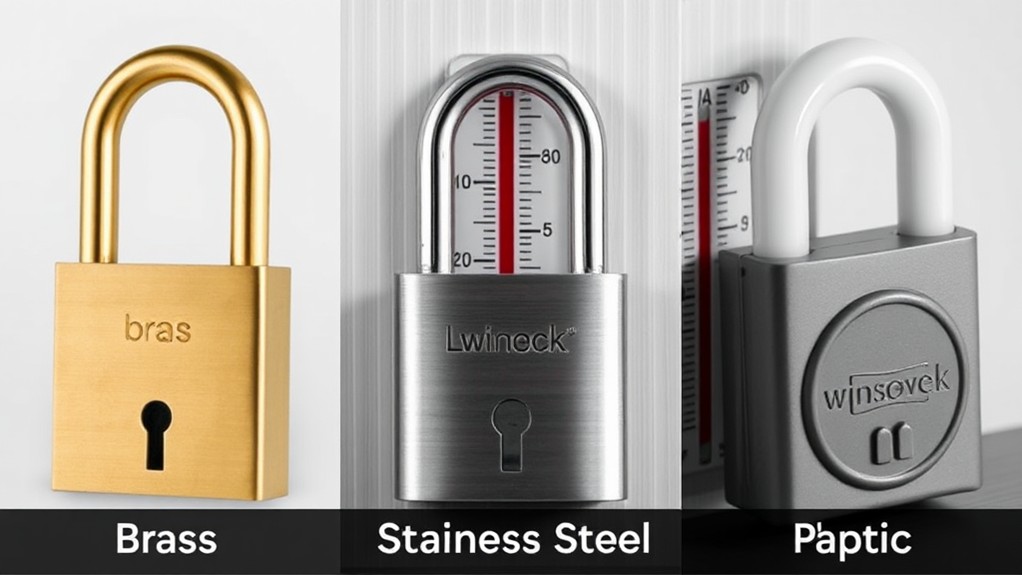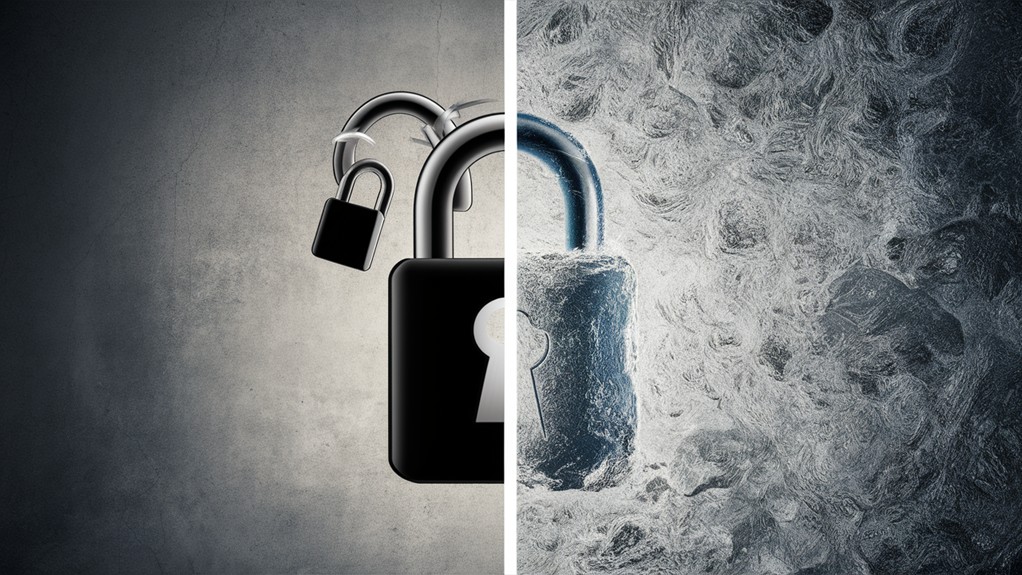When securing your property with locks, you likely know that extreme temperatures can impact their performance, but you may not realize that even moderate temperature fluctuations can cause metal contraction, friction, and stiffness, leading to difficulties with key insertion and lock operation. You'll want to take into account locks made from materials like stainless steel or brass for corrosion resistance, and opt for protective coatings or temperature-resistant locks for outdoor use. Regular maintenance, including seasonal inspections and lubrication, is likewise essential. Understanding how temperature and humidity affect locks is key to ensuring their reliability, and exploring these factors further can help.
How Temperature Affects Locks
When you're dealing with locks in extreme temperatures, you'll likely notice a difference in their performance.
Extreme temperatures can greatly impact the functionality of lock mechanisms, particularly regarding key insertion.
In cold temperatures, metal locks contract, leading to increased friction and stiffness of moving parts. This makes key insertion more difficult and may even prevent the key from turning.
Conversely, high temperatures cause metals to expand, potentially misaligning lock components and making it challenging to insert or turn keys effectively.
Some key ways temperature affects locks include:
- Increased friction and stiffness in cold temperatures, making key insertion more difficult
- Misalignment of lock components in high temperatures, hindering key insertion and operation
- Thinning or evaporation of lubricants in high temperatures, increasing friction and the likelihood of lock malfunction
Understanding how temperature affects locks is essential for maintaining their performance and longevity.
Impact of Humidity on Locks
Extreme temperatures aren't the sole environmental factor that can affect lock performance – humidity also plays a crucial role. As a lock owner, you need to evaluate the impact of humidity on your locks to guarantee their optimal functionality and longevity.
High humidity levels can cause rust formation on metal locks, leading to decreased functionality and potential failure of internal components.
Here are four key ways humidity can affect your locks:
- Rust formation: High humidity levels can lead to rust formation on metal locks, compromising their strength and durability.
- Internal mechanism failure: Moisture can cause internal locking mechanisms to seize, making it difficult to operate the lock and turn the key.
- Mold growth: Damp conditions can promote mold growth, which may interfere with the mechanical operation of the lock.
- Electronic lock damage: Prolonged exposure to moisture can damage electronic locks, potentially leading to electrical failures and compromised security.
To lessen these effects, focus on rust prevention and moisture management.
Utilizing dehumidifiers in areas with high humidity can greatly reduce moisture levels and help maintain lock efficiency.
Weather-Related Lock Maintenance

Effective lock maintenance is key to guaranteeing your locks withstand the elements. To achieve this, it's vital to implement a seasonal maintenance schedule, addressing specific weather-related challenges throughout the year.
Seasonal Inspections and Maintenance
Regular seasonal inspections are important to identify potential issues before they become major problems. For instance, autumn is an ideal time to check for rust, while winter is the perfect season to confirm lubricants are effective.
Consider the following maintenance tasks:
- Clean locks with a mild detergent to remove dirt and moisture that can lead to rust and malfunction.
- Lubricate locks annually with a silicone-based spray to prevent sticking as a result of temperature-induced expansion or contraction of metal components.
- Use weather-resistant locks for outdoor applications to minimize the impact of rain, snow, and high humidity on lock functionality.
Lubrication Techniques
To keep your locks running smoothly, use the following lubrication techniques:
- Apply a silicone-based spray to the lock's moving parts.
- Wipe off any excess lubricant with a cloth to prevent attracting dirt.
Security Risks in Extreme Weather
In harsh weather conditions, your locks become particularly vulnerable to security risks that can compromise the safety of your home or business. Extreme weather can weaken your locks' integrity, making them more susceptible to lock tampering and increasing the risk of break-ins.
- Rust and corrosion: High humidity levels can lead to rust formation on metal locks, potentially causing internal components to seize or malfunction, thereby weakening their security.
- Frozen mechanisms: Cold temperatures can cause lock mechanisms to freeze or become brittle, resulting in potential failures when quick access is needed during emergencies.
- Power outages: Severe weather events can lead to power outages that affect electronic locks, leaving properties vulnerable until power is restored.
- Malfunctioning locks: Severe weather conditions can as well cause locks to malfunction, compromising emergency access when you need it most.
To reduce these risks, it's crucial to inspect and maintain your locks regularly, especially during seasonal changes. This helps guarantee they remain reliable and secure against weather-related vulnerabilities.
Choosing the Right Lock Material

In relation to protecting your property, a lock's material composition is just as crucial as its design and functionality. When choosing the right lock material, consider the following key factors to guarantee optimal performance in varying temperatures.
Lock Material Properties
Locks made from materials with specific properties can greatly impact their performance in extreme temperatures. For instance, stainless steel and brass are preferred materials because of their corrosion resistance and durability against temperature-induced expansion and contraction.
Furthermore, locks made from materials with low thermal conductivity, such as plastic composites, can help alleviate temperature fluctuations, reducing the risk of jamming or malfunctioning.
Key Considerations
- Corrosion resistance: Look for locks with protective coatings, like powder coating or galvanization, to improve resistance to rust and corrosion.
- Temperature ratings: Select locks specifically rated for extreme temperatures, as manufacturers often provide specifications indicating operational limits for both cold and hot climates.
- Material flexibility: Opt for locks designed with materials that remain flexible in cold weather, preventing brittleness and breakage.
Frequently Asked Questions
Can I Use WD-40 to Lubricate Locks in Freezing Temperatures?
When lubricating locks in freezing temperatures, you might consider using WD-40, but it's not the best option. For effective lock maintenance, you're better off using lubricant alternatives like silicone sprays or powdered lubricants for longer-lasting results.
Do Electronic Locks Perform Better in Cold Weather?
You'll find electronic locks generally perform well in cold weather, as their internal mechanisms are less affected by temperature. They're often battery-powered and sealed, reducing the risk of freezing or corrosion, making them reliable options.
Can Extreme Temperatures Damage Smart Lock Batteries?
You'll likely find that extreme temperatures can damage smart lock batteries, reducing their lifespan. Temperature effects on batteries can be considerable, with both hot and cold temperatures impacting battery performance and general battery lifespan considerably.
Are Weather-Resistant Locks More Secure Than Regular Locks?
You'll find that weather-resistant locks generally offer better durability than regular locks, but that doesn't necessarily mean they're more secure. Temperature effects can still impact lock performance, so consider the comprehensive lock quality, not just resistance.
Can I Install Locks in Direct Sunlight Without Affecting Performance?
You can install locks in direct sunlight, but consider the impact on performance. Choose heat-resistant materials, apply a UV shield, and guarantee proper installation with seals to minimize sunlight effects and guarantee durability.
